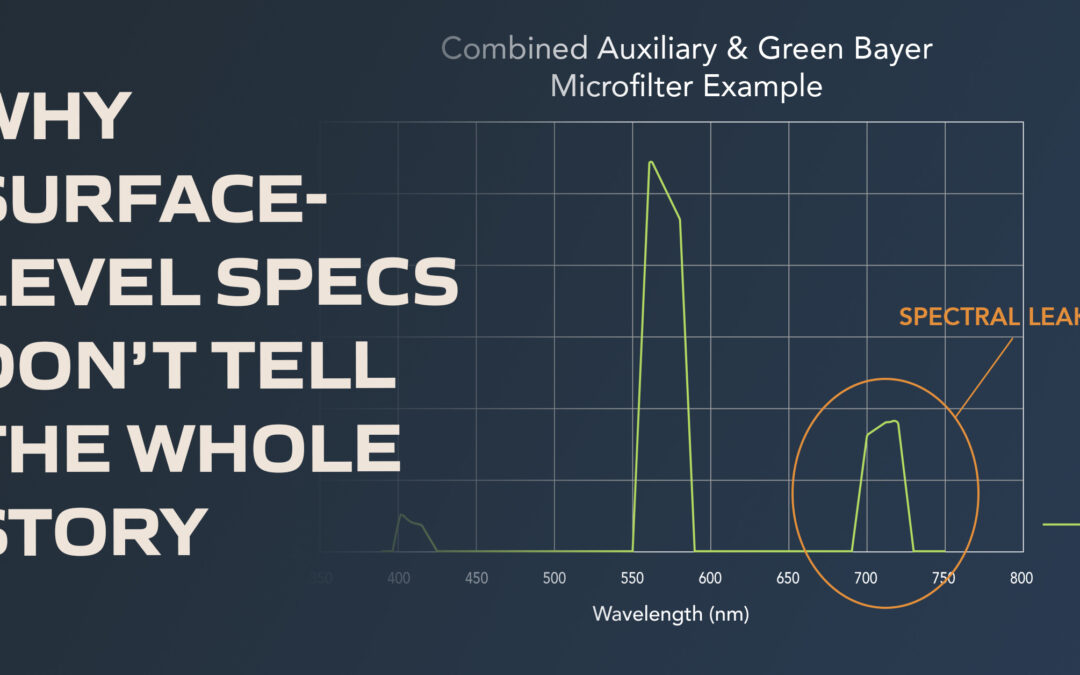When it comes to multispectral sensors, the first impression is often based on specifications—number of bands, resolution, or even price. But while these specs are important, they don’t tell the whole story. Two sensors might look similar on paper or even externally, but the way they collect, process, and deliver data can be fundamentally different. Understanding these differences is critical for selecting the right sensor for your needs.
At Sentera, we’ve worked extensively with both dedicated-channel systems, like our 6X Multispectral sensor, and multi-channel systems, like our Double 4K sensor. This unique experience gives us a balanced perspective on the trade-offs between these architectures—and why what’s behind the specs matters more than you might think.
It’s Not Just About the Bands
One of the most common metrics people evaluate is the number of spectral bands a sensor can capture. More bands often imply more data, more insights, and better results. But this metric alone doesn’t tell you:
-
- How are the bands filtered? Dedicated-channel systems use precise bandpass filters to isolate each band, ensuring minimal spectral leakage. Multi-channel systems rely on auxiliary filters and microfilter arrays, which can introduce overlap and reduce accuracy.
-
- What’s the effective resolution per band? A sensor may advertise high resolution, but in a multi-channel system, resolution is divided among all the bands captured by a single imager.
-
- How is radiometric accuracy maintained? Dedicated-channel systems fully block unwanted wavelengths, while multi-channel systems face challenges with spectral leakage.
Questions to Ask Before You Buy
Before investing in a multispectral sensor, consider these key questions to go beyond the marketing claims:
1. What architecture does the sensor use?
Dedicated-channel systems offer precision but may come at a higher cost. Multi-channel systems are compact and cost-efficient but can have trade-offs in data quality.
2. How is data calibrated and aligned?
Dedicated-channel systems often require post-processing to align bands, but this can be automated. Multi-channel systems capture all bands simultaneously, but the data may need correction for spectral overlap.
3. What are the effective resolution and radiometric accuracy?
Look beyond the advertised resolution and ask about how the pixels are allocated across bands. For multi-channel systems, interpolation might inflate the resolution numbers without improving data quality.
Sentera’s Perspective: Why Experience Matters
Sentera brings a unique perspective to this conversation. Not only do we offer both dedicated-channel (6X Multispectral) and multi-channel (Double 4K) systems, but we’ve also developed patented technology for optimizing multi-channel performance. This breadth of expertise allows us to guide users in choosing the right sensor for their application, whether precision or efficiency is the top priority.
With a deep understanding of the trade-offs between these systems, we’re here to help you look past the specs and ask the right questions.
Explore the Science Behind Multispectral Imaging in Our Precision Filtering White Paper
Our white paper, Precision Filtering: Dedicated-Channel and Multi-Channel Systems, provides a comprehensive guide to understanding:
-
- Filtering methods and how they impact spectral precision.
-
- Effective resolution in dedicated and multi-channel systems.
-
- Key questions to ask when evaluating sensor technology.
Whether you prioritize precision or efficiency, this resource helps you make informed decisions for your multispectral sensing needs.
Click the button below to access your copy and make informed decisions about your multispectral sensing needs.

